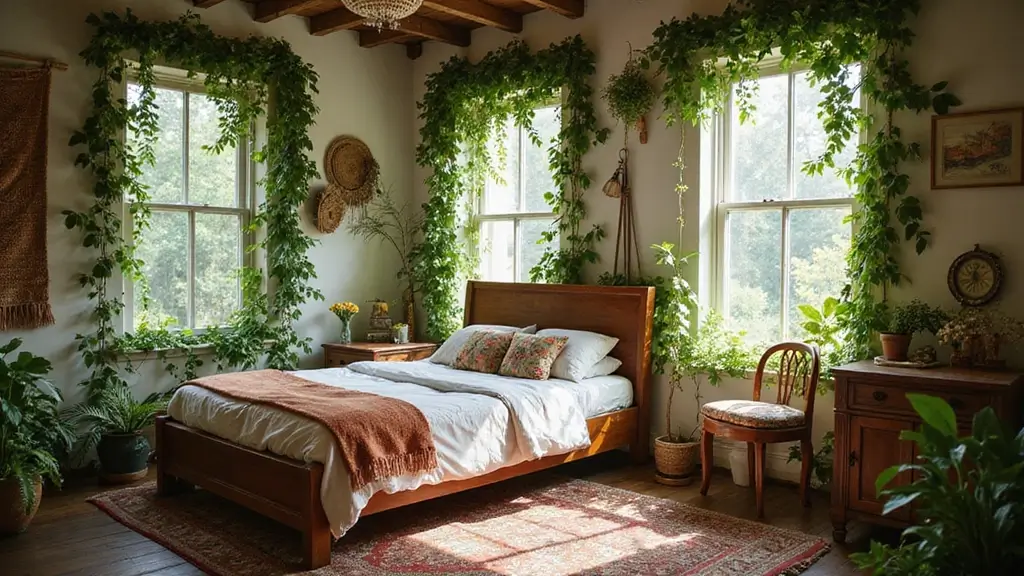I started this post because I want a bedroom that feels alive with green. The idea of vines weaving along a wall or curling over a shelf makes the room feel fresh and calm. I looked for simple, doable ways to bring nature inside without a big project or a lot of care.
If you love a cozy room and care about light, texture, and tiny details, this one’s for you. If you rent and can’t paint, or you simply want easy changes you can swap out later, you will find ideas that fit.
What you’ll get: I pulled together 25 practical vine ideas that are doable, stylish, and friendly to real life. You’ll learn where to place vines, how to hang them, and how to choose vines that thrive in a bedroom. We’ll cover light, humidity, and simple care steps so your greens stay lush.
These ideas cover many moods: a calm retreat behind a pane of glass, a lively frame around the bed, or a playful wall of vines that climbs a corner. You will find tips on low light spots, budget twists, and quick fixes you can finish this weekend. Easy, beautiful setups fit busy lives.
Bringing vines indoors does more than add color. It adds texture, softens lines, and can lift mood. You feel more connected to nature when you wake up to a green trail by your nightstand. The scent of leaves and soil with the morning light can change the feel of a room.
Ready to start? Pick a couple of spots you see every day, grab a few starter vines, and try a simple setup. You can hang a string of hearts from a hook, let pothos drape over a shelf, or train a philodendron up a tall stake. This post gives you ideas, not rules, and you can mix, match, and tweak until it fits your space.
1. Trailing Pothos in Hanging Baskets
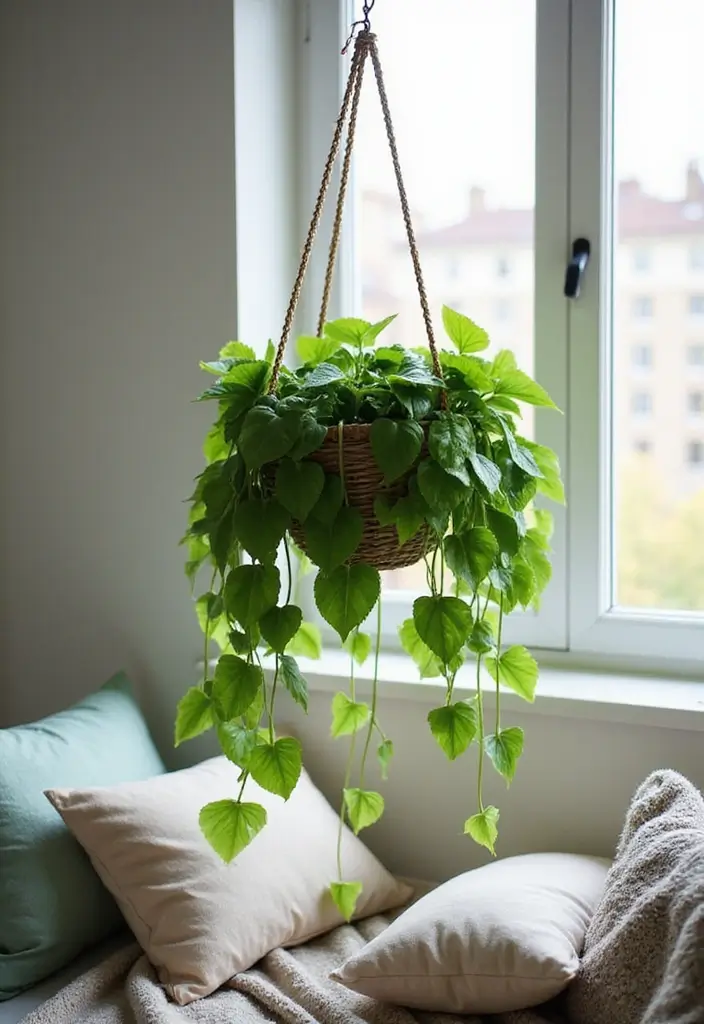
You want a splash of green that takes little effort. The trailing pothos fits. It grows well in indirect light and helps clean the air. Its long leaves spill over the edge, creating a soft green curtain from your ceiling.
Where to put it? Near a window or in a corner so the vines can reach out. A hanging basket with a simple hook or a wall planter makes the vine feel alive without using floor space.
Choose baskets that match your room. Wicker, ceramic, or a macrame hanger can blend with your style.
– Care tip: keep the soil lightly moist, not soggy. Check every few days and water when the top inch feels dry.
– Light tip: place in bright, indirect light. Too much sun can scorch leaves; too little slows growth.
– Prune tip: trim dead or long strands. Regular trimming helps the plant stay full and lush.
With a pothos in a hanging spot, you get movement, texture, and a calmer bedroom vibe. It’s simple, green, and easy to maintain.
Next steps help you stay on track. If the plant looks pale, move it a touch closer to light. If leaves turn yellow, check moisture and drainage. Rotate the pot every month so growth stays even.
Elevate your space with trailing pothos! These effortless vines add a lush touch while purifying your air. Hang them near windows for a vibrant, cascading green that breathes life into your bedroom.
2. Ivy on a Wall Trellis
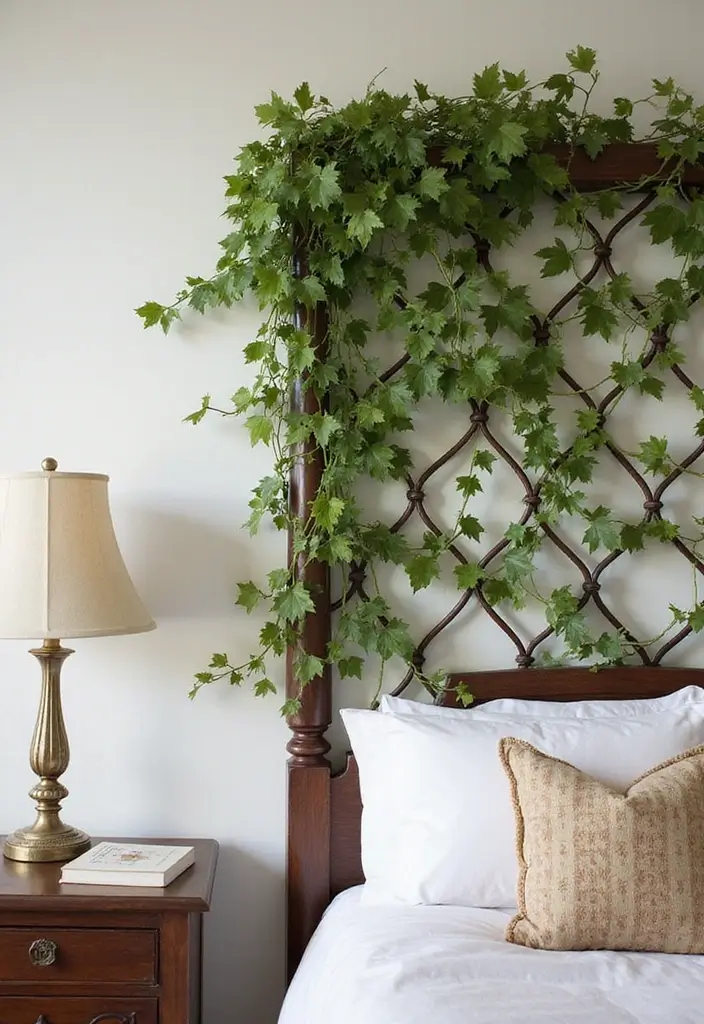
You want a bedroom that feels bigger and calmer. A wall trellis lets ivy cover vertical space without stealing floor area. The result is a living focal point that adds depth and a touch of nature.
Ivy grows well in moderate light and it keeps care simple. It gives you a green wall you can look at every day.
– Choose a trellis that fits your wall. Pick one that matches the height and width of your space. Leave room for ivy to grow so it doesn’t feel cramped.
– Set it up securely. Mount the trellis on studs or use anchors. A sturdy base keeps the vine from wobbling as it thickens.
– Train ivy to climb. Start with the main stems and guide them toward the lattice. Use soft ties sparingly to avoid damage.
– Prune regularly. Trim back long shoots every few weeks. This keeps the wall tidy and prevents the ivy from blocking your light.
– Pair ivy with other plants. Add a contrasting plant nearby for texture. This mix makes your greens feel layered and natural.
With ivy draped along your walls, the bedroom feels cozy and calm.
3. String of Hearts on Shelves
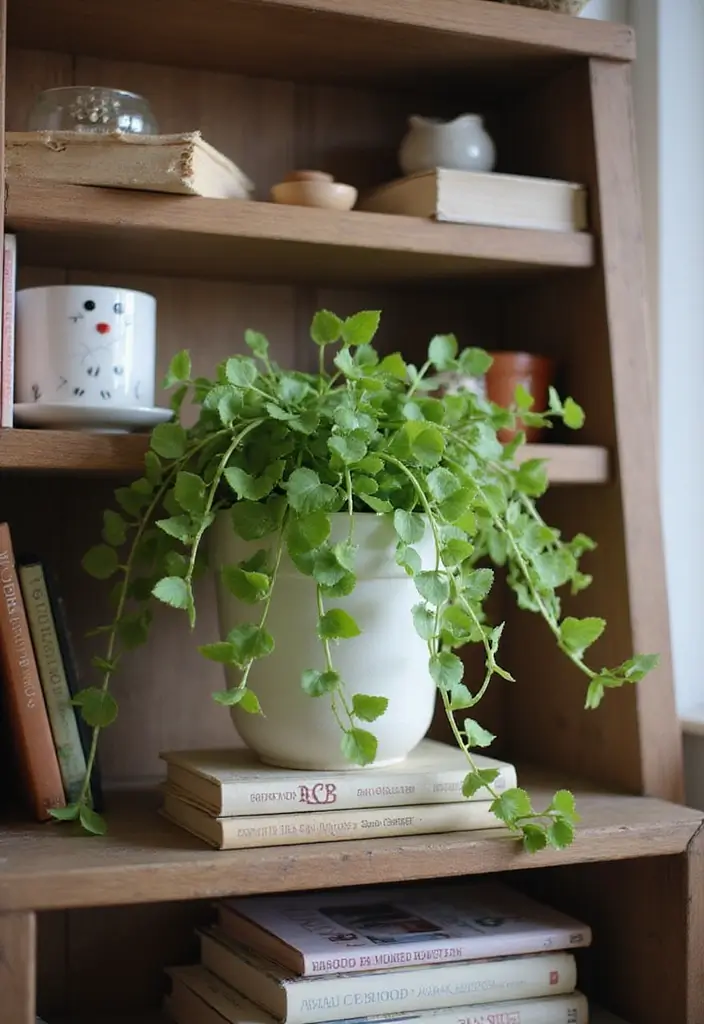
You want a vine that adds calm charm to your bedroom without taking over. The String of Hearts fits that need. Its small heart-shaped leaves trail on long stems, making a quiet curtain along a shelf. It loves bright, indirect light and does best on a sunny book ledge.
Here’s how to use it.
– Pick a slim shelf or a low bookcase. Let the vines dangle so the leaves sweep over the edge.
– Choose pots that match your style. White, stone, or soft pastels help the leaves stand out and tie the shelf to your bed area.
– Water sparingly. Let the soil dry between drinks. Check the mix with your finger to avoid soggy roots.
– Pair it with other low-water plants. A tiny succulent or a small aloe adds helpful contrast in texture.
– Make sure there is drainage. A pot with a hole and a shallow tray keeps excess water away from the wood.
Why it helps your room: it brings life in a gentle way and stays low effort. With light care, you’ll notice longer hanging stems and more heart leaves over time.
Keep an eye on the soil and adjust as the season shifts. You can swap colors later.
4. Climbing Philodendron on a Moss Pole
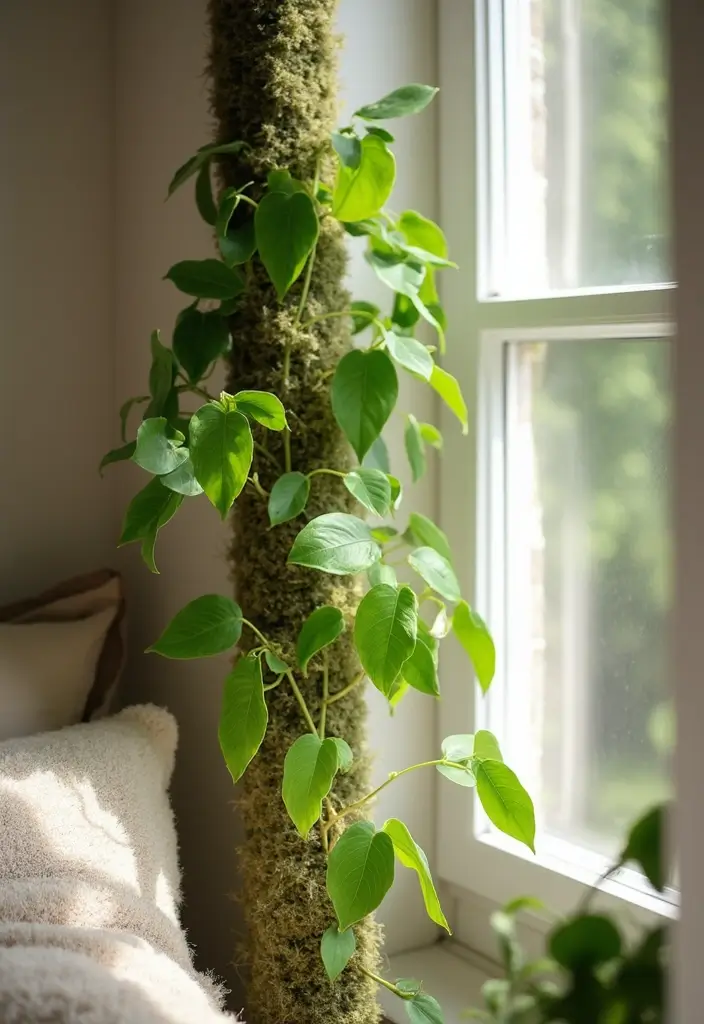
Here is why you should try a climbing philodendron on a moss pole in your bedroom. It grows tall, stays tidy, and needs simple care. The moss pole gives it a natural stake, so the vine climbs up instead of sprawling on the soil. It adds texture and helps the plant feel rooted.
Choose the moss pole and pot
– Pick a pole that fits your planter and plant size.
– Use a decorative pot so the setup matches your bedroom style.
– Put the pole in the pot with fresh potting mix for strong roots.
Train the plant to climb
– Gently direct the stems toward the pole.
– Tie lightweight stems with soft ties so you avoid damage.
– Check weekly and nudge new growth onto the moss pole.
Water, light, and air
– Water the moss pole so the moss stays damp. Do not oversaturate.
– Place the plant in bright indirect light.
– Keep humidity comfortable; mist leaves occasionally.
Care and maintenance
– Inspect for pests and wipe leaves clean.
– Check ties as the plant grows and adjust them.
– Feed monthly in spring and summer with a diluted fertilizer.
Next steps: with this setup, your bedroom gains a lush climbing vine that helps purify the air and lifts your mood.
5. Sweet Potato Vine in a Decorative Bowl

Sweet Potato Vine in a Decorative Bowl
You want a touch of nature in your bedroom without a lot of work. A sweet potato vine fits that brief. The leaves show bright greens, bronze, or purple. It trails over a bowl, giving your room a lush, fresh feel.
Display ideas
– Use a bowl with a drainage hole, or put a small pot inside with a liner.
– Place in bright indirect light. Too little dulls color; too much can scorch.
– Let the soil dry a bit between waterings. Water when the top inch dries.
Care tips
– Use a light, well-draining mix.
– Water regularly, but avoid soggy soil. Check moisture with your finger.
– Feed lightly in spring and summer, once a month.
This vine is forgiving and quick to rebound if you slip up. It adds color and a soft, modern vibe to your space.
Common questions
– Will it fit in a small room? Yes, it stays compact when kept in a bowl setup.
– Is it hard to care for? Not really. Consistency with light and moisture helps a lot.
Try different bowls to match your room style. It’s simple.
Take action
Set up the bowl, place it in a bright indirect spot, and enjoy the color. If you want more drama, add a second vine nearby.
6. Basic Ropes for Natural Hangings

Looking to bring nature into your bedroom without a big makeover? Rope hangings let vines spill from the ceiling and walls while you keep floor space free.
Here is why this works.
Ropes add a warm, rustic touch and give your plants a new home high above the floor.
What you’ll use
– Use sturdy, natural fibers.
– Cotton rope, jute, or hemp look good.
– They stay strong and last.
How to setup
– Hang from ceiling hooks.
– Use wall anchors rated for plant weight.
– Tie a simple knot and snug the rope.
How to lay it out
– Create a layered display.
– Suspend pots at different heights.
– This builds a vertical garden that feels lush.
Light and care
– Match light needs.
– Place the setup where each plant gets the right sun.
– Include bright indirect light for shade lovers.
Safety and finishing touches
– Safety and maintenance.
– Check knots for looseness.
– Watch for rope fraying.
Final touches
– Finish the look.
– Pair rope with wood frames and soft textiles.
– Add leafy greens to complete the natural vibe.
Take it slow. Start with one vine and a single rope.
Observe how the plant grows, and adjust height and light as needed.
This simple setup can change the mood of your room without wasting space.
You can add more ropes later as you grow.
Try it this weekend.
7. Hoya Plant on a Windowsill
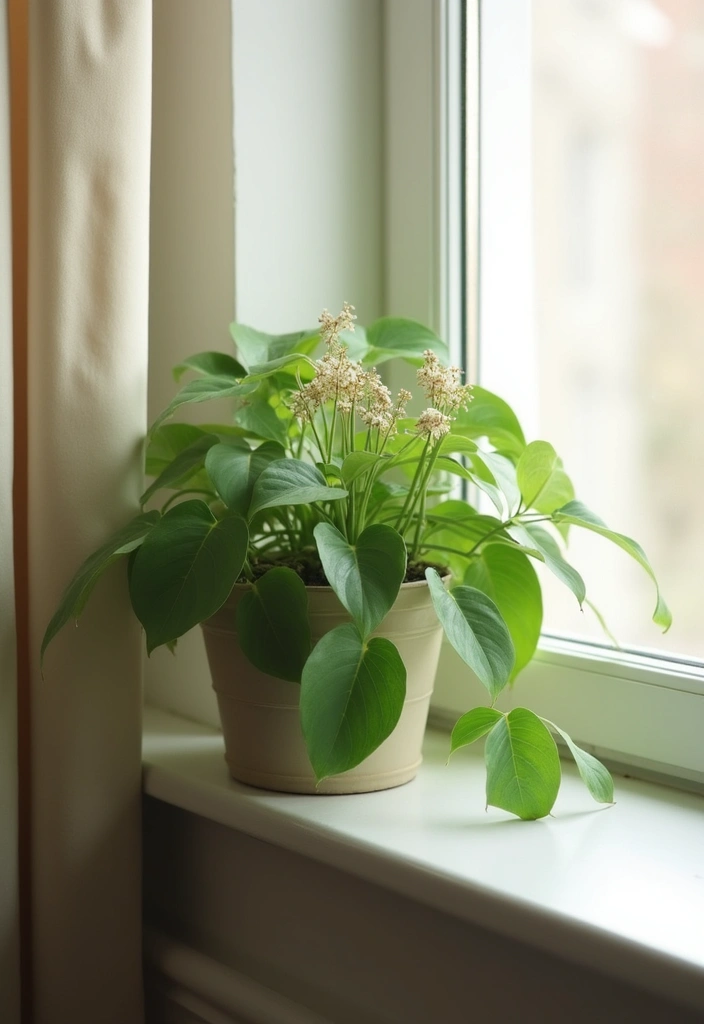
Want a splash of tropical calm in your bedroom without a lot of fuss? The Hoya vine fits that need. It likes bright but indirect light and does well in small spaces, especially on a windowsill. Here are practical steps to set it up and keep it thriving.
– Light and placement: Put the pot on a sunny windowsill with bright, indirect light. Morning sun is fine. If afternoon sun is strong, use a light curtain to soften the rays.
– Watering schedule: Water deeply when the top inch of soil dries. Hoyas hate soggy roots. Drain any extra water and let the soil dry a bit between drinks.
– Soil and pot: Use a fast-draining mix, like a blend of regular potting soil with a bit of sand or perlite. Make sure the pot has drainage holes. Pick a style that matches your window frame so it looks part of the room.
– Leaf care and cleaning: Wipe dust from the leaves with a damp cloth every few weeks. Clean leaves help the plant breathe and keep its color tidy.
– Training the vine: Hoyas like to trail. Let the stem wander along a slim stake or gently curve along the sill. Give it space to grow, and don’t crowd it.
– What to expect: Indoors, Hoyas may bloom after some time if light stays bright. If blooms appear, you’ll see small clusters of star-shaped flowers. If leaves curl or feel soft, adjust light or water.
Next steps. Place your Hoya on the window and start with moderate light. Watch how it settles in and tweak care as needed.
8. Air Plants in Glass Terrariums
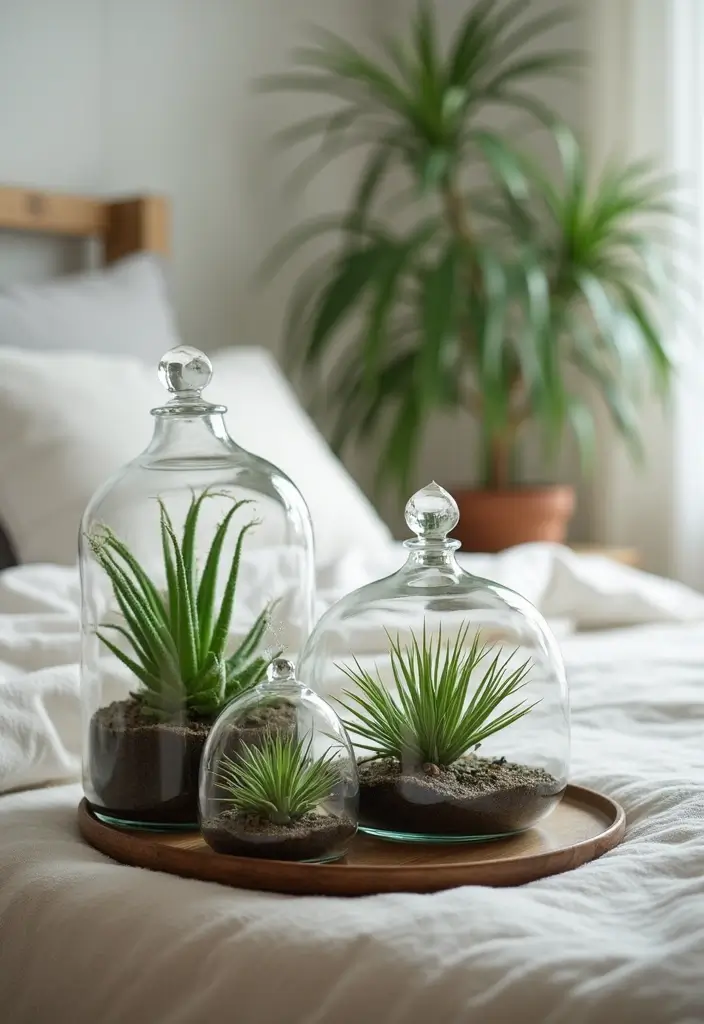
You want a touch of nature in your bedroom without a mess. Air plants in glass terrariums fit the bill. Tillandsias need no soil, so they sit cleanly inside clear holders. Their shapes range from soft rosettes to sharp spikes, and they catch the light in a calm, modern way.
Here is how to style air plants so they shine.
– Mix different shapes and sizes You’ll get instant visual interest by pairing a soft rosette with a tall, pointy sprout. Cluster a few in one terrarium or use several small ones on a shelf. The variety keeps the display lively.
– Place them where light flows Put the terrarium near a bright window with indirect sun. Too much direct sun can scorch leaves. Rotate the setup every couple of weeks so all plants get light.
– Water the right way Soak the terrarium in room temperature water for two to three hours every two weeks. Afterward, shake off excess water and let the plants dry completely in a sunny, open spot. In a dry room, you can mist lightly between soaks, but never leave standing water.
– Display ideas that suit bedrooms Hang a single piece from a slim hook, or rest a small cluster on a shelf with smooth stones. Clear glass makes the green pop and keeps the room feeling airy.
– Care and signs If leaves brown, give more light; if they curl, check water. Keep it simple, and you’ll enjoy this calm green accent.
Transform your bedroom into a tranquil oasis with air plants in glass terrariums. Their unique shapes bring the beauty of nature indoors, all without the mess of soil!
9. Bougainvillea on a Large Stand
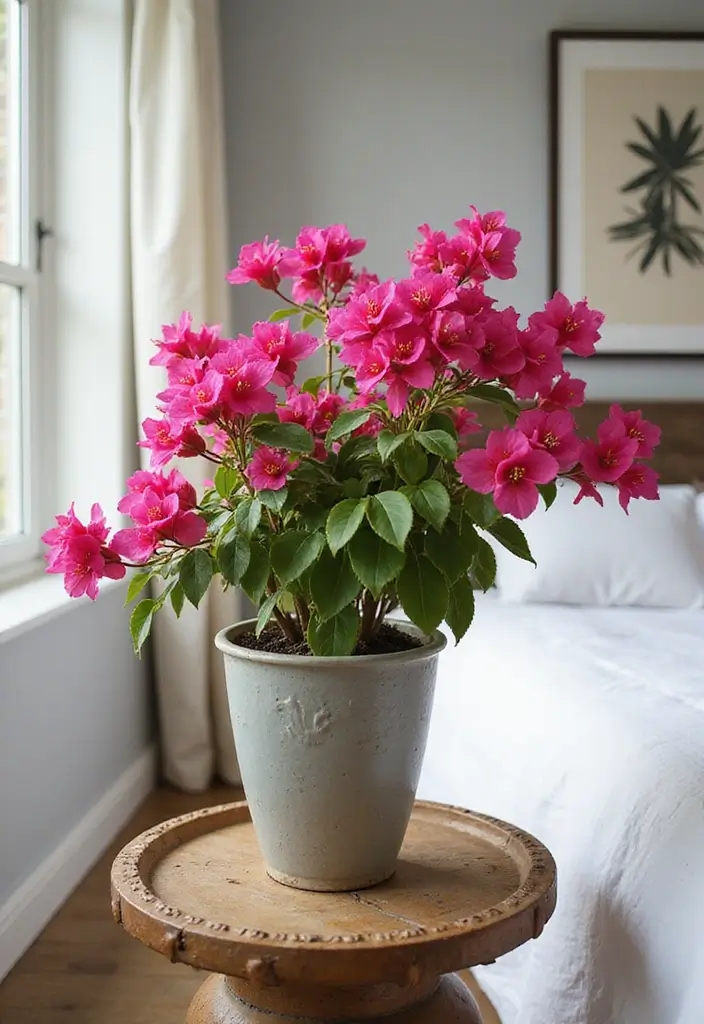
You want a plant that adds real energy to your bedroom. Bougainvillea does that with bold color and lively blooms. Set it on a tall stand or pedestal so its flowers can be seen from across the room. A bright, sunny spot makes this vine glow.
Here is why it works well indoors: bougainvillea loves bright light. Near a window is best. If the light is weak, the plant will grow tall and sparse, and blooms may stall.
Care essentials
– Use a pot with good drainage. Water can’t sit in the soil. A tray on the sill catches extra water.
– Water deeply but only when the top inch dries. This keeps roots happy and helps flowers form.
– Pinch back tips to keep the plant compact. Regular trimming also helps more branches and more flowers later in the season.
– Feed lightly in spring and summer with a balanced plant food. Do not overfeed.
– Move the plant away from cold drafts. Bougainvillea dislikes sudden chills.
Next steps: watch for after-bloom trim needs, and re-check light in winter. Add a second plant or a vertical plant wall if you want more greenery.
This setup favors quick blooms and a lively display in your room.
10. Jasmine Climbing on a Lattice
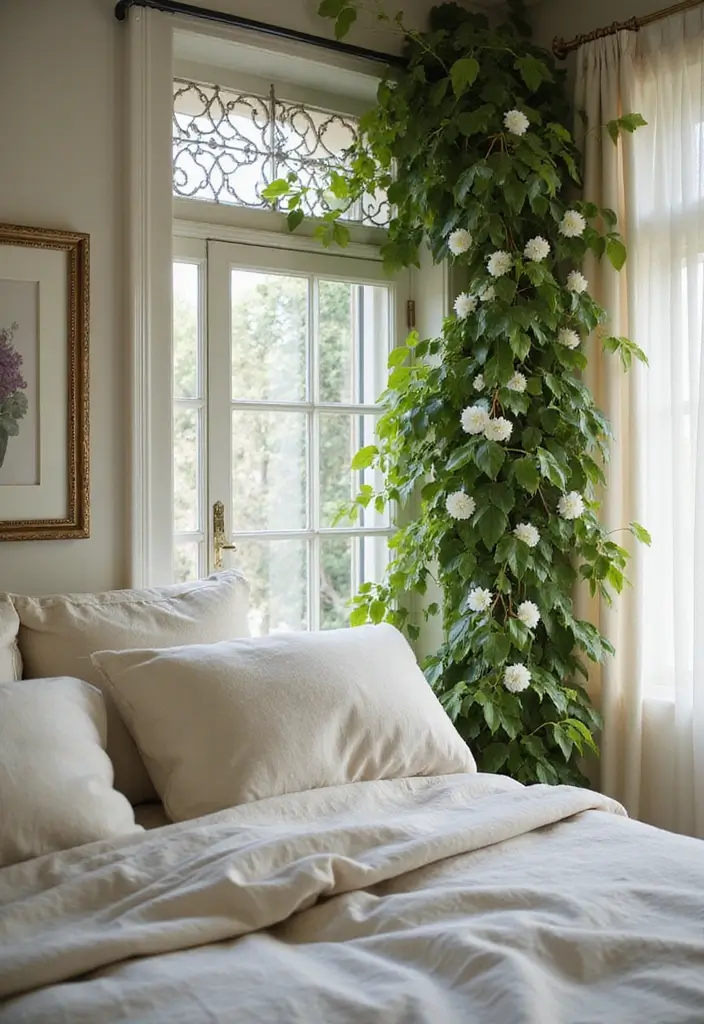
You want a bedroom that smells fresh and feels calm. Jasmine climbing on a lattice gives both. It adds a green screen and its scent greets you when you walk in.
Choose a lattice that fits your space. A wood frame or light bamboo panel works well. Mount it on the wall near a bright window so the plant gets indirect light and the scent can drift through the room.
Here is how to care for jasmine indoors:
– Light Put the plant in bright, indirect light. Direct sun can burn the leaves.
– Water Keep the soil evenly moist, not soggy. Check the top inch and water when it dries.
– Humidity A little extra moisture helps. Mist the leaves.
– Pruning After flowering, trim to keep a neat, bushy shape.
– Feeding Use a balanced fertilizer in spring and summer. Follow the label and avoid overfeeding.
Training the vines on a lattice is simple. Place the plant near the panel. Guide new shoots to the slats and tie gently. Check as it grows.
Next steps: enjoy the scent as you enter. Wipe dust from the leaves to keep the plant healthy. If the fragrance feels too strong, move the lattice a bit away.
Transform your bedroom into a serene oasis with jasmine vines! Their enchanting scent and beautiful lattice support not only elevate your decor but also create a calming retreat that welcomes you home.
11. Rattlesnake Plant in a Corner Pot
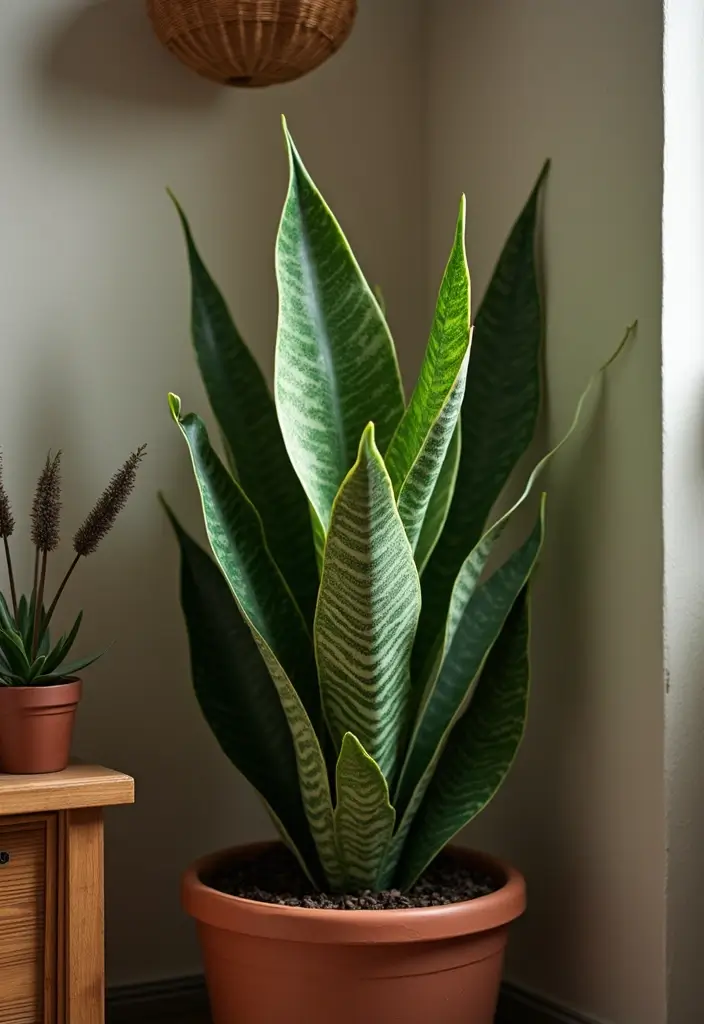
You want a bold, easy fix for a bedroom corner. The rattlesnake plant, also called Calathea lancifolia, brings striking leaves to a calm room. Its long leaves are olive with dark spots, and the undersides shine purple. In a corner pot, it becomes a focal point you notice every day. The look adds texture without clutter.
Here is how to keep it healthy. It thrives with indirect light and steady care. It does not need bright sun to shine.
– Light: Indirect light is best. Avoid harsh afternoon sun that scorches the leaves.
– Water: Check the top inch of soil. When it dries, water well. Use room temperature water and let excess drain.
– Humidity: Mist the leaves a few times a week or set the pot on a tray with water and pebbles.
– Soil and pot: Use a well-draining potting mix. A pot with drainage holes helps prevent soggy roots. Repot every 1-2 years.
– Care tips: Wipe the leaves to remove dust. Trim brown tips. Rotate the plant so all sides get light.
This plant adds color and texture to your room and keeps the air feeling fresher with light maintenance.
Next, common questions you might have. Is it a vine? No. It stays in a pot and does not climb. It likes steady room temps and a bit more humidity to stay lively.
Ready to try it? Pick a corner with gentle light, choose a pot with drainage, and follow these steps. Your room will feel brighter with little effort.
12. Grapevine Accents on a Headboard
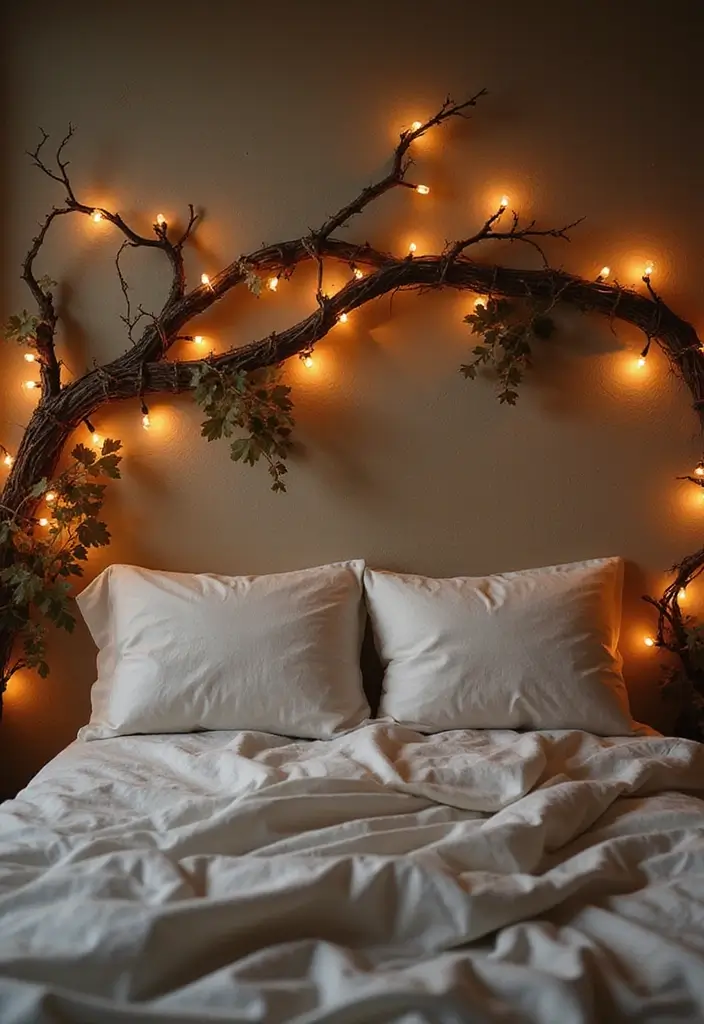
You want a touch of nature in your bedroom that feels simple and calm. Grapevine accents on a headboard do that. The vines frame the bed with a soft, earthy glow and don’t overwhelm the room.
Here is why it works: the twisting stems add texture, and the leaves bring a quiet, garden-like vibe. It’s a small change that makes the space feel welcoming.
– Choose your vine: Real grapevines give texture and a faint wood scent. If you want less upkeep, pick faux grapevines that look natural and stay green longer.
– Attach with care: Use tiny hooks or natural twine to wrap around the headboard. Start at the top corners and follow the frame. Tuck in stems so you get a neat, tidy look.
– Light it softly: Add a string of warm fairy lights. Weave them through the vines to cast a gentle glow at night for a dreamy effect.
– Trim and tidy: Check every few weeks. Trim any stray tips and dust the leaves. Real vines may dry a bit; fake vines stay vivid with a quick wipe.
– Style tips: Pair grapevines with neutral sheets, soft greens, and wood or rattan furniture. Let vines drape slightly for a relaxed, boho feel.
This small upgrade makes your bed feel calmer and more inviting without heavy work.
13. Climbing Roses in a Planter
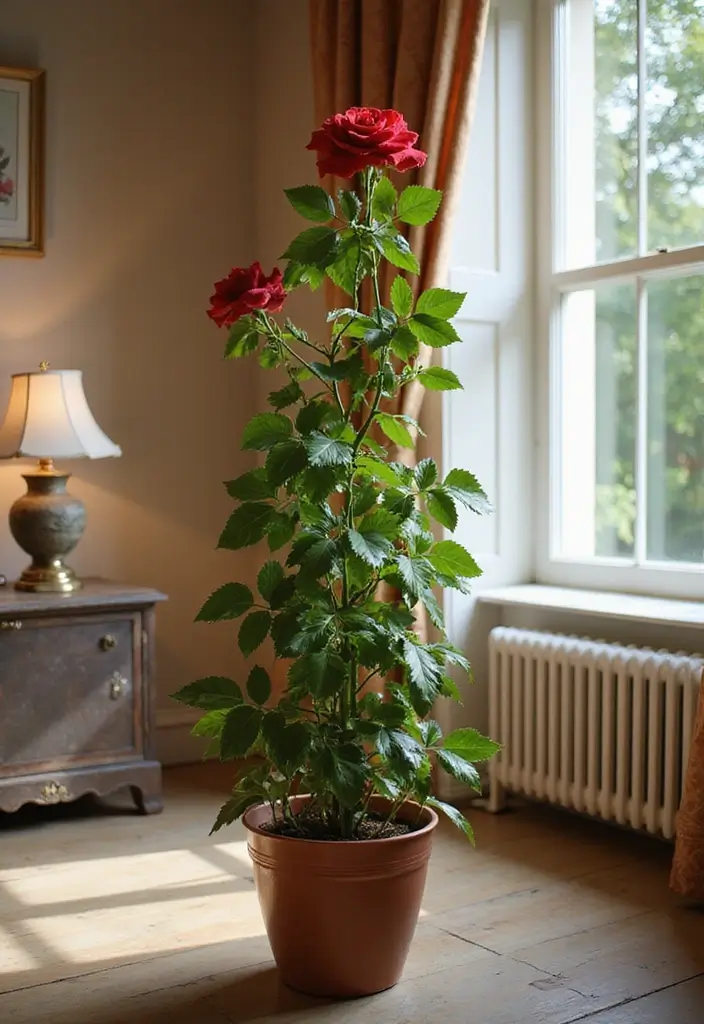
You want a touch of beauty that fills your room with scent. Climbing roses in a planter can do that. They add soft color and a gentle perfume. Placed by a sunny window, they feel like a small garden you can keep inside.
Here is how to make it work.
– Pick the right planter Choose a pot with drainage holes. A saucer catches extra water. Use fresh potting mix for flowering plants. Good soil helps roots stay healthy.
– Light and location Put the planter near a bright window. Roses love light. If possible, give them four to six hours of sun daily.
– Water and soil care Water when the top inch dries. Do not let the pot sit in water. Keep the soil evenly moist, not soggy.
– Training and pruning Tie stems to a small trellis. Prune after a bloom cycle to keep shape. This helps new flowers form.
– Feeding and upkeep Feed every 4 to 6 weeks during growth. Pause feeding in fall.
– Care and protection Watch for pests. Remove yellow leaves. Rotate the pot so growth stays even.
With care, these indoor climbing roses bring a garden mood to your room. This setup fits small rooms and tight budgets.
14. Ferns Hanging from the Ceiling

Struggling to add green life to a small bedroom without crowding shelves? Hanging ferns from the ceiling is a simple, stylish fix. They spill a soft curtain of leaves above you and give the room a calm, forest vibe you can enjoy every day.
Why ferns work here:
– They like humidity and do well in dim light, perfect for bedrooms.
– They trail softly, catching light and moving with a breeze.
How to hang ferns the right way
– Pick a sturdy hanging planter with drainage so the soil stays healthy.
– Install a ceiling hook into a joist or a strong anchor that can carry the weight.
– Choose trailing ferns such as Boston or maidenhair for a lush cascade.
– Place the planter where it won’t brush your face or snag curtains.
Care basics you can do in minutes
– Water regularly but keep the soil slightly moist; avoid soggy soil.
– Mist the fronds now and then to boost humidity.
– Check for brown tips and trim them to encourage new growth.
What you get
– A softer, textured look that makes the room feel bigger and calmer.
– A quiet, living touch that stays neatly indoors.
Next steps
– Start with one easy fern, set a simple watering schedule, and watch your ceiling turn into a green crown.
15. Trailing Succulents in Decorative Bowls
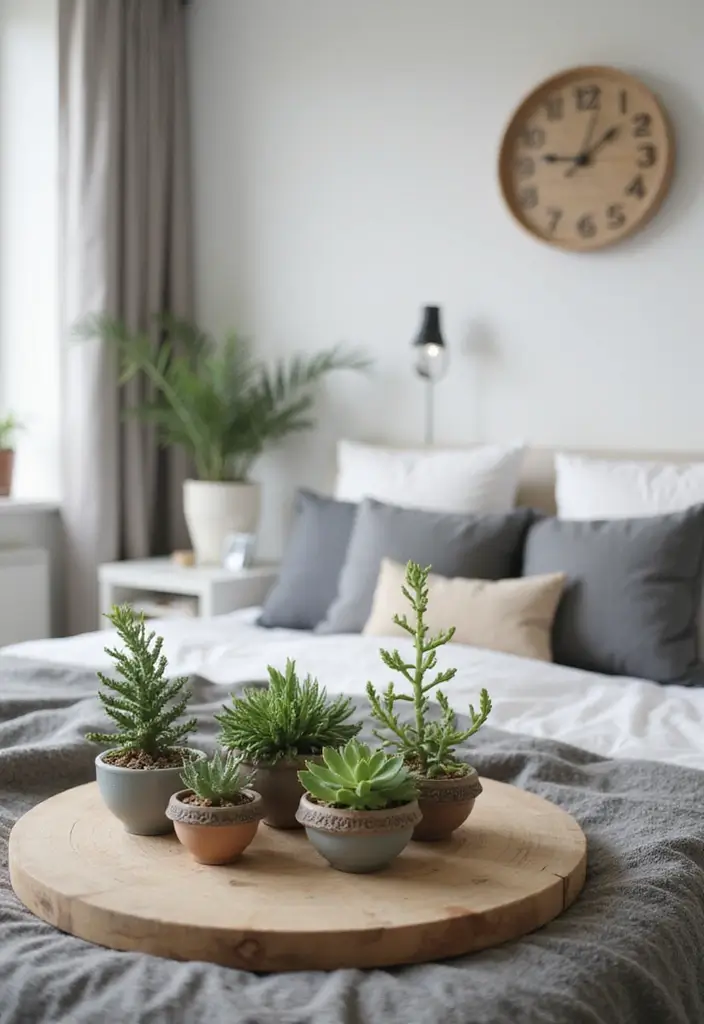
Why trailing succulents work in a bedroom
You want a calm, green touch with little effort. Trailing succulents in decorative bowls give that vibe and stay easy to care for. Their hanging leaves soften hard edges and add texture you can see and feel.
What you’ll need
A shallow, wide bowl in ceramic, glass, or light wood. A well-draining soil mix, like cactus mix with perlite. A small pot inside the bowl if drainage is not present. Bright indirect light nearby. A few varied succulent types for texture.
Step-by-step styling
– Pick a bowl that lets stems spill over the edge so the plants cascade gracefully.
– Use a draining soil mix to keep roots happy and avoid rot.
– If there is no drain in the bowl, place a pot inside and use the bowl just for display.
– Water sparingly; let the soil dry completely between waterings.
– Mix colors and shapes such as burro’s tail, string of pearls, and small Sedums to add depth.
– Put the bowl in bright indirect light so leaves stay plump and colors pop.
– Set the display on a dresser, shelf, or beside your bed where it catches soft morning light.
Care and maintenance
Rotate the bowl every few weeks and prune any leggy growth to keep the cascade tidy. This setup keeps care simple and your room calm. You can tweak colors to match your bedding. Next steps: pick a bowl and start.
16. Indoor Vines with Fairy Lights
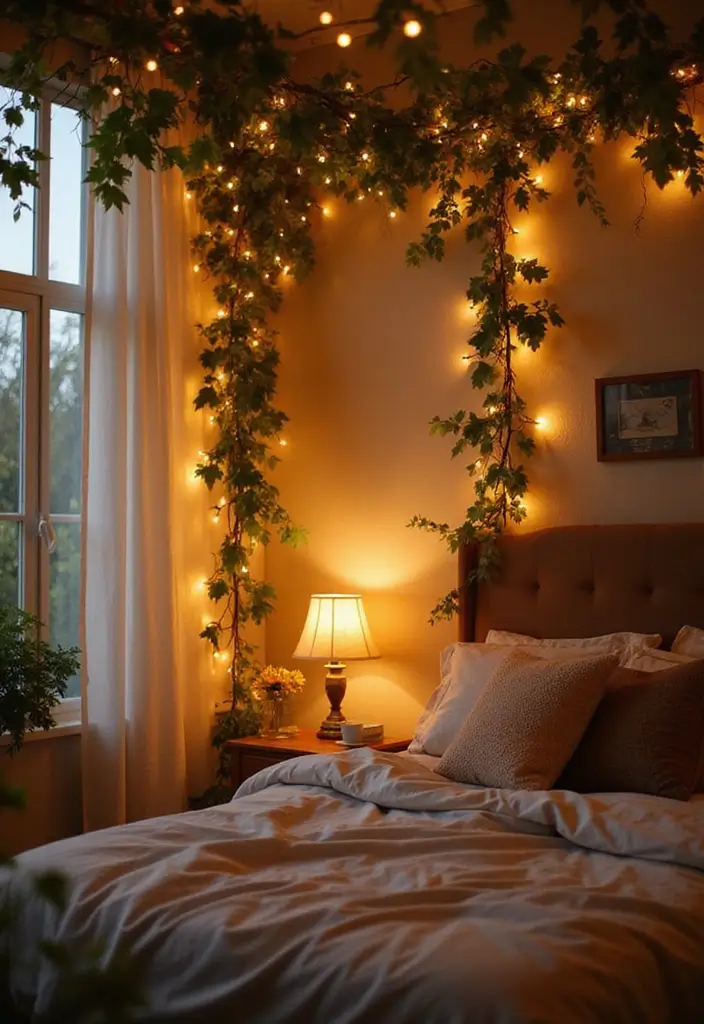
You want a bedroom that feels calm and alive. Indoor vines with fairy lights can make that happen. The soft glow creates a soothing mood after dark, while green leaves add a fresh, natural note. Here’s a simple way to pull this off.
What you’ll need\n
– battery‑operated fairy lights, warm white for a cozy look\n
– a pothos or ivy plant, plus flexible vine stems that can wrap gently\n
– small scissors or twist ties to tidy the wrap
How to set it up\n
– Start with a plan. Think of a simple path along the headboard or a loop around a mirror. Keep the line clear and easy to follow.\n
– Wrap the lights around the vines loosely. Begin at the base and work upward, letting leaves stay visible.\n
– Hide the battery pack in a plant pot or behind a frame so it isn’t seen. A neat wrap makes the glow seem to come from the greens themselves.\n
– Plug in or switch on the lights and check the spread. Adjust gaps so the vines breathe and the glow stays even.
Placement ideas\n
– Drape vines along the bed edge with lights woven through the leaves. It looks like a green halo.\n
– Let two or three strands create depth, not clutter. Don’t crowd any one leaf.\n
– Try a small focal area first, then expand to a larger green glow as you grow more confident.
Care and safety\n
– Use warm white lights for a soft, nighttime feel. Cold tones can feel stark at bedtime.\n
– Check that wraps aren’t pinching stems or leaves.\n
– Keep cords away from damp spots and water bowls. Dry, safe setups last longer.\n
– Prune vines occasionally. A tidy growth keeps the look fresh and calm.
Next steps\n
– Test a short section this weekend. If you like it, extend the setup to other corners of the room.
– Keep the look balanced. One green glow is enough to transform the space without crowding it.
17. Vertical Garden Wall with Various Vines
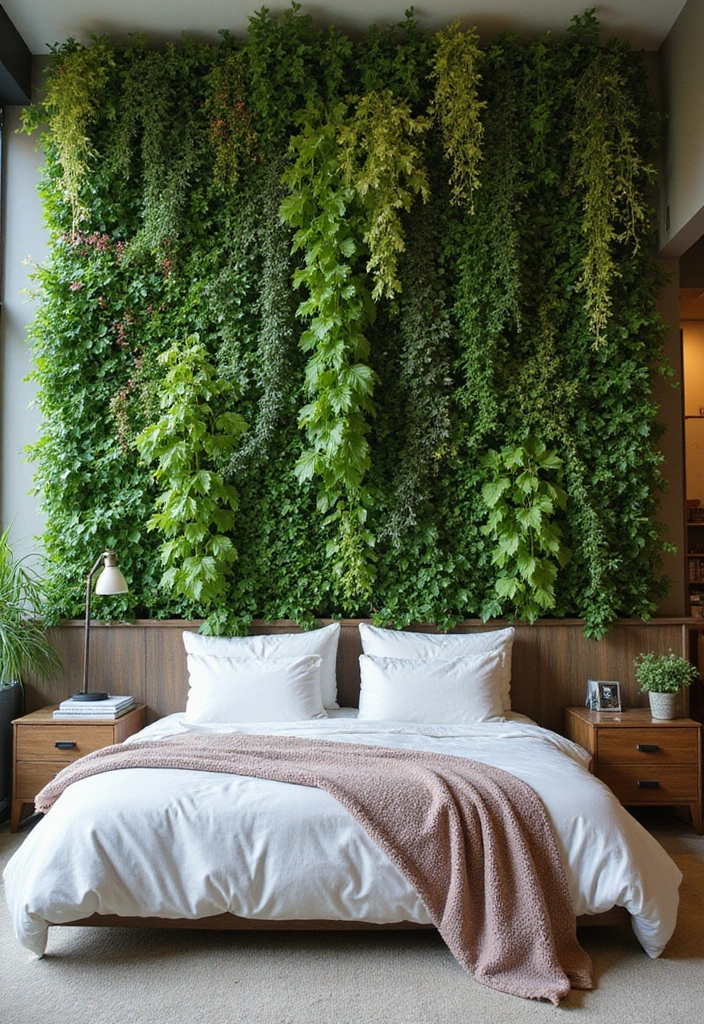
Want a living focal point in your bedroom without stealing floor space? A vertical garden wall fits a splash of green in a slim area. You can stack several vines in one tall display. Ivy, pothos, and philodendron mix textures nicely.
Here is why it works in small rooms. It adds color and depth. It makes the room feel calmer. You control the look by mixing leaf shapes and shades.
Materials and setup
– Wall mounted planters or a trellis to hold the vines
– A sturdy frame or grid, like wood slats or metal mesh
– Lightweight, fast draining soil and a tray to catch water
– Vines such as ivy, pothos, philodendron, or creeping fig
– Anchors, screws, and a drill for a confident mount
How to build it
– Plan height and space so each plant has room to grow
– Mount the frame firmly to studs
– Train each vine onto the grid, guiding stems as they stretch
– Water when the top inch of soil dries; avoid soggy roots
– Place near bright light, or add a small grow light
– Trim growth to keep a neat, full look
A green wall saves floor space and adds life to your bedroom. It can grow with your taste and needs.
18. Vines Wrap Around Headboards
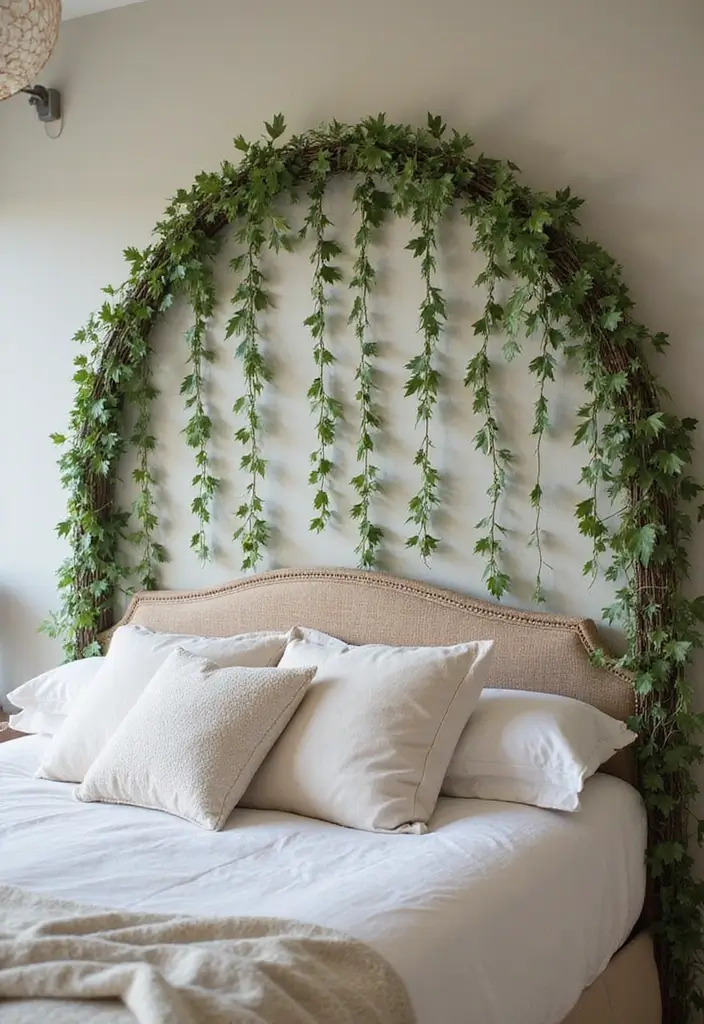
Want a calm, nature-inspired bedroom? Wrapping vines around your headboard adds life without clutter. This simple touch brings the look of a garden close to your bed. You get texture, a soft scent, and a green backdrop that helps you wind down.
Choosing the vines
– Pick flexible options like ivy or jasmine that can bend around the headboard without pulling on the frame.
– Consider your room light. Ivy loves bright spots, while jasmine needs a bit more sun to thrive.
– Use healthy vines with few yellow leaves for a clean, tidy look.
Attaching them safely
– Attach vines with soft fabric ties or removable clips so you won’t drill holes or scratch the frame.
– Tie vines to the top and sides of a sturdy wood headboard, or wrap them around a padded, fabric-covered panel.
– Keep vines away from pillows and sheets to avoid snagging or staining.
Style and care
– Layer the greens with light textiles like a linen throw and a soft blanket to balance the look.
– Let the vines hug the edges, not crowd the center, for a neat, restful feel.
– Prune as needed to keep the shape tidy and to prevent overlap into your sleeping space.
Maintenance tips
– Check weekly for loose stems or signs of mold, especially in humid rooms.
– Trim every few weeks to control growth and keep the look fresh.
– Clean leaves with a damp cloth to keep them bright and healthy.
With these steps, your headboard becomes a living feature that brings nature into every night.
19. Mixed Planter with Vines and Other Plants
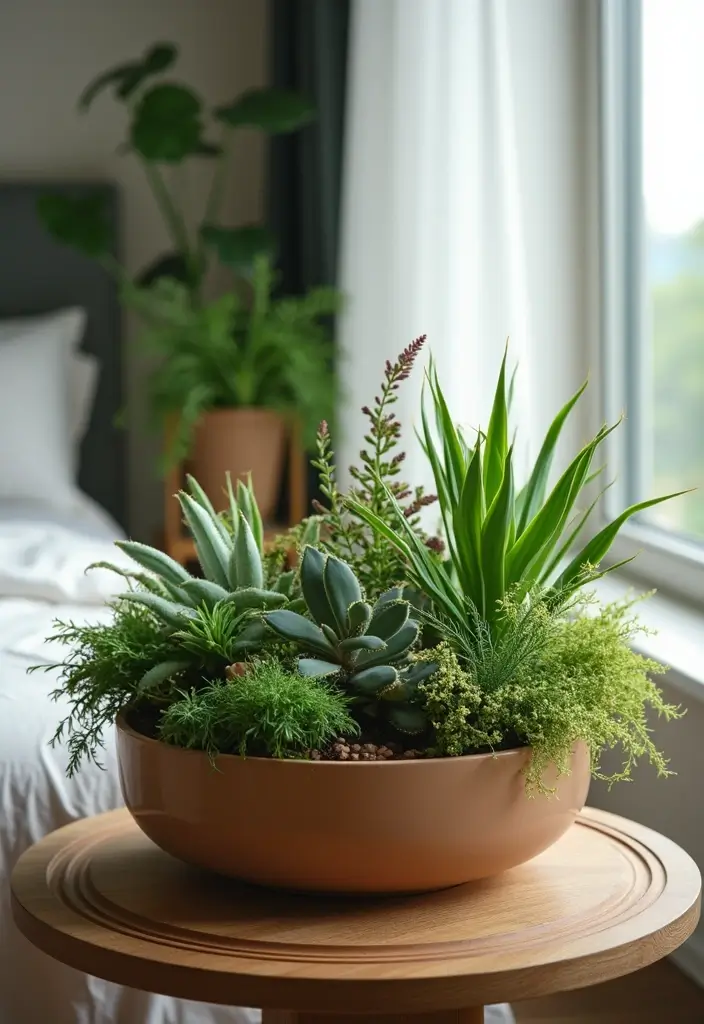
Mixed Planter with Vines and Other Plants
Here is why this setup helps your bedroom. A mixed planter brings color, shape, and texture in one look. It adds life without crowding shelves.
Let’s build it.
– Choose plants with the same light and water needs. Pothos or ivy pair well with ferns or snake plants. This makes care easier for you.
– Plan the layout. Put taller plants at the back. Let trailing vines spill forward so the arrangement feels full.
– Pick the right pots. Use containers with drainage. A shallow tray or saucer keeps spills off your furniture for you.
– Use a common soil mix. A light, well draining potting soil works for most houseplants. It helps you keep care simple.
– Care smart. Water when the top inch of soil is dry. Do not let roots sit in water. Indirect bright light helps all members. Your plants will stay healthy with this.
– Rotate regularly. Every couple of weeks, switch positions so every plant sees light. This means you get even growth over time.
– Keep it tidy. Pinch back long vines. Wipe dusty leaves to keep them shiny and healthy. Your planter will look neat.
Next steps: gather a sunny corner, pick two or three compatible plants, and start with two matching pots. Watch your room feel greener and calmer.
20. Vines in Corner Shelf Displays
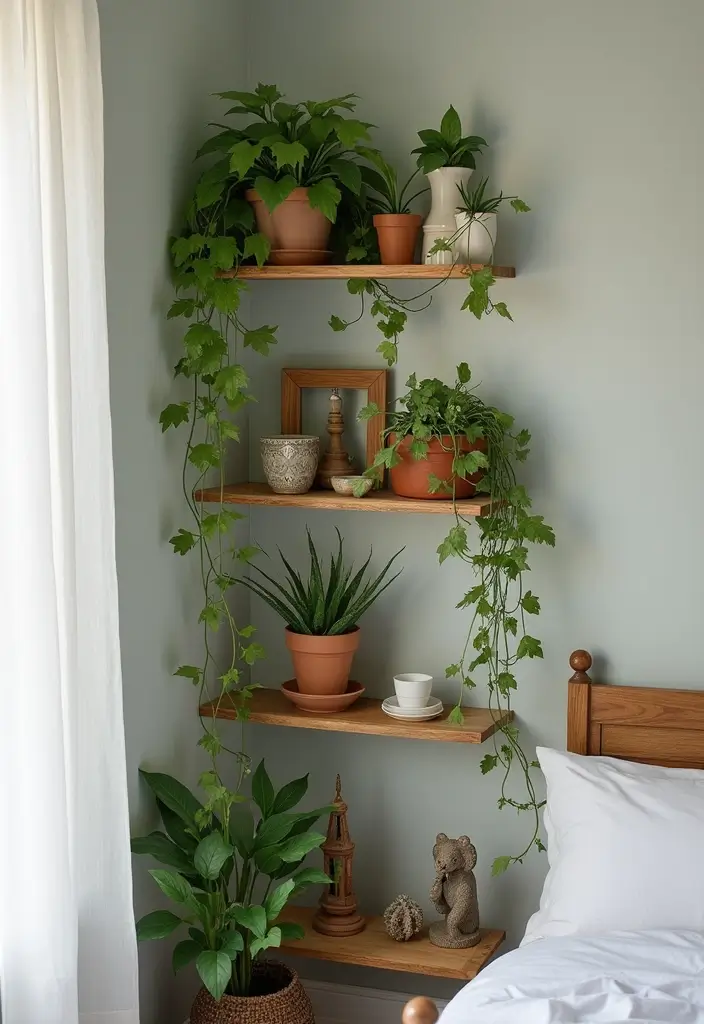
Here is why corner shelves make a strong vine display. They fill empty space without crowding the room. You get a layered look that catches the eye. Leaves catch light and move with the air, giving your room a fresh feel.
Here is how to start. Choose vines that fit your light. String of Hearts, pothos, and philodendron are forgiving. Use pots with drainage. Don’t overwater.
Next, arrange with purpose. Tall vine at the back, shorter ones in front. Mix leaf shapes for texture. Add a small book or pot to balance the color.
Care tips you can follow. Let light match each plant’s needs. Water when the top inch of soil dries. Check for limp tips and trim them.
Maintenance plan. Rotate shelves every two weeks to keep growth even. Prune long stems to keep fullness. Wipe dusty leaves with a soft cloth.
Common questions. Will vines crowd the shelf? Trim to keep growth tidy. Do I water from the top or bottom? Water until it drains from the pot.
Next steps.
– Gather a few easy vines.
– Set up a two-plant display to start.
– Add one new vine each month.
21. Wall-Mounted Vines in Unique Pots
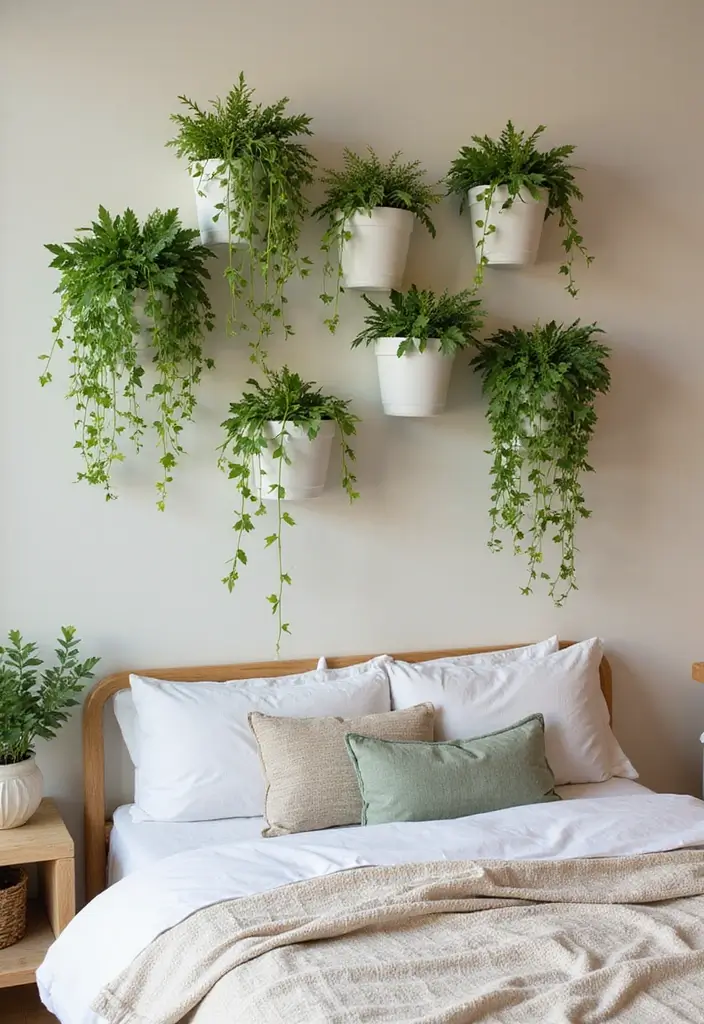
Here is why you want wall mounted vines in unique pots. You get a live touch on a wall without crowding the floor. The result is a calm, natural look in your bedroom.
Here is why this setup works: it saves space, creates a strong focal point, and lets you swap pots or plants with the seasons.
Let’s break it down.
– Hardware that holds Use sturdy wall brackets or strong adhesive hooks that can support the weight of pots and vines.
– Pot planning Pick pots that fit your color scheme. Mix shapes and sizes, but keep a simple rhythm so it reads clean.
– Plant choices Try ivy, philodendron, or pothos. These vines trail nicely and stay green most of the year.
– Layout idea Start with a straight row or a small cluster. Leave space for growth and eye travel up the wall.
Next steps: mount at eye level so you can reach for care easily. Check the vines every 2 to 4 weeks, trim dead leaves, and water only when the soil dries. Use drip trays to catch excess water.
This wall display adds texture and a soft, natural feel to your room. It stays stylish while needing little upkeep, and it grows with your space.
22. Spiral Vines Around Stair Railings
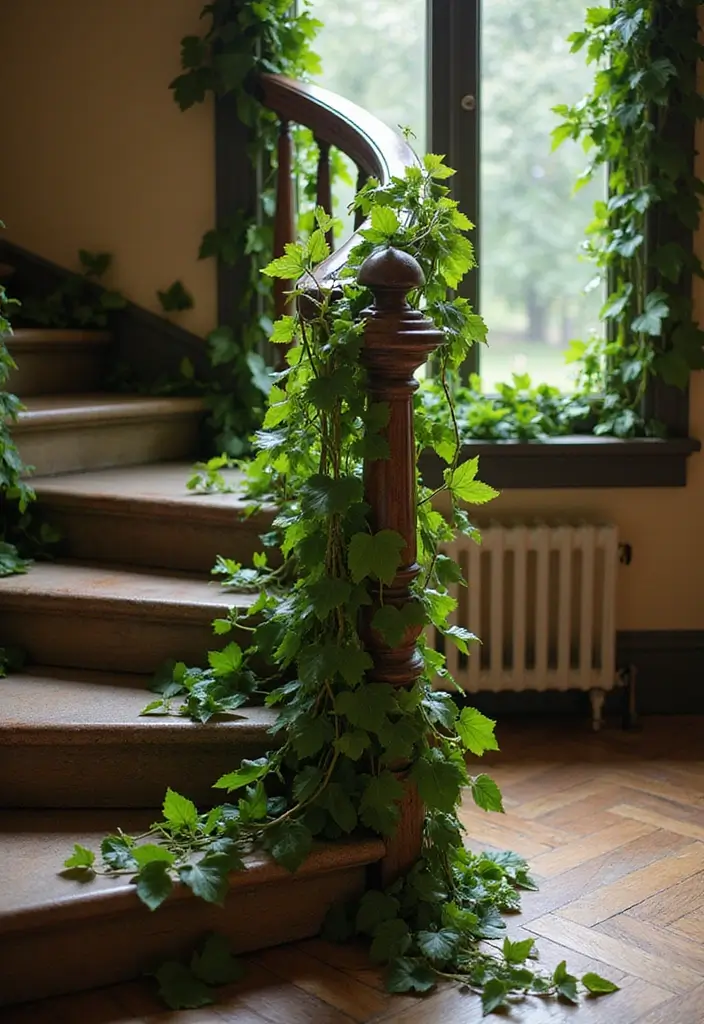
If your bedroom has a stair rail, you can let vines spiral around it. A winding green line up the rail looks calm and cool. It turns a plain feature into a living moment.
Here is why it helps: a living curve adds texture and color to the room. It also softens hard edges and can hide rough spots on the rail. Start with a plan you can see.
– Choose the vines. Pothos and philodendron are easy to care for. They grow fast and stay green most of the year.
– Check health. Pick vines with strong leaves. Trim any yellowing bits. Make sure roots look healthy.
– Attach safely. Use soft ties or plant clips. Tie lightly so the bark is not pressed. Hide the ties as you go.
– Install gently. Begin at the bottom. Weave the stem around the rail as you rise. Keep the twist loose so air and water move freely.
– Care as you go. Water when the soil dries. Give light that fits the plant. Rotate the vines a bit so they grow evenly.
– Watch and trim. Look for too much overhang. Prune short branches to keep the path clear.
– Finishing touch. If you like, add small clips at hidden spots or a thin layer of moss to hide ties.
Next steps: check weekly, adjust growth, and enjoy the green curve.
Let your vines in bedroom ideas spiral around stair railings for a calming touch! Embrace nature indoors and transform hard edges into soft curves that breathe life into your space.
23. Rustic Wood Ladder Displaying Vines

Rustic Wood Ladder Displaying Vines
If you want a natural touch in a small bedroom, a rustic wood ladder is a smart choice. It turns a plain corner into a living display. You can show several indoor vines at once without crowding the floor. The wood adds warmth while the plants bring color and life with every glance. You set it up in minutes and it grows with your plants.
– Materials and style: Pick a ladder that fits your room.
– Pots and finishes: Use rustic pots such as terracotta or woven baskets.
– Plant placement: Layer vines on each rung for depth.
– Watering: Water by each plant’s needs.
– Light and location: Place the ladder where it gets the right light.
To keep this setup healthy, remember simple care. Check soil moisture weekly and water only as needed. Rotate the ladder slowly so every plant gets balanced light over time. Trim vines if they get crowded and wipe dust from leaves. If you use trailing varieties, let them spill softly down the sides for a relaxed look.
This display adds texture, color, and a calm vibe to your room. It also makes the most of vertical space while keeping care easy.
24. Vines Framing Windows

If you want a natural border for your bedroom window, vines can do the job. They frame the view, bring a touch of outdoors inside, and soften strong sun into gentle light.
Choose the right vines
– Pick slim, indoor-friendly climbers like pothos, philodendron, or creeping fig. They stay neat and grow along the frame without crowding the glass.
– If you love scent or a splash of color, consider jasmine or a small climbing rose, but only with good support and bright, indirect light.
– Avoid heavy climbers that can overwhelm the window or block the glass.
Set up a slim frame
– Attach a lightweight trellis or a line of small hooks along the window edge.
– Use soft ties or plant-safe twist ties to guide the stems.
– Keep enough space so you can open and close the window easily.
Train and prune for shape
– Gently guide vines along the frame as they grow.
– Check weekly and trim any shoots that spill onto the glass or crowd the view.
– A monthly prune keeps lines clean and the plants healthy.
Care and practical tips
– Use a well-draining pot and moderate watering. Let the top inch of soil dry before watering again.
– Mist leaves or use a humidifier to help tropical varieties thrive.
– Monitor for sun spots; rotate pots a bit so growth stays balanced.
What to expect and limits
– You gain a natural border, softer light, and a calm green touch in your room.
– Vines may reduce some window visibility or light if they grow too dense. Prune regularly to keep both views clear.
Next steps: plan your window, pick a vine, and start with a small frame. You’ll create a living border that refreshes your space every day.
25. Colorful Vines for Seasonal Decor

Seasonal vine picks
Are you hoping to refresh your bedroom without a big redo? Colorful vines that shift with the seasons are a simple, low effort move. They add color, texture, and a touch of the outdoors. It won’t break your budget or take much time. You can store vines when the season ends.
Next steps to make it work.
– Seasonal picks fit your light and space, from bright to shaded.
– In spring, flowering vines give bright blooms and a light scent.
– Use decorative pots and displays that match the season, like pastels in spring or warm terracotta in autumn.
– Rotate vines every 4 to 6 weeks for a fresh look.
– Create a small display with a wall trellis, hanging basket, or shelf to keep changes easy and visible.
– Be honest about limits and pick hardy foliage vines if your light is low.
– If you have a busy schedule, plan swaps on weekends and keep a small vase.
If you keep notes, you can plan future swaps around holidays. This habit makes changes even smoother. Try it this month.
This approach keeps your space lively and easy to manage. Start with one seasonal swap and you will feel the room brighten gradually.
Conclusion
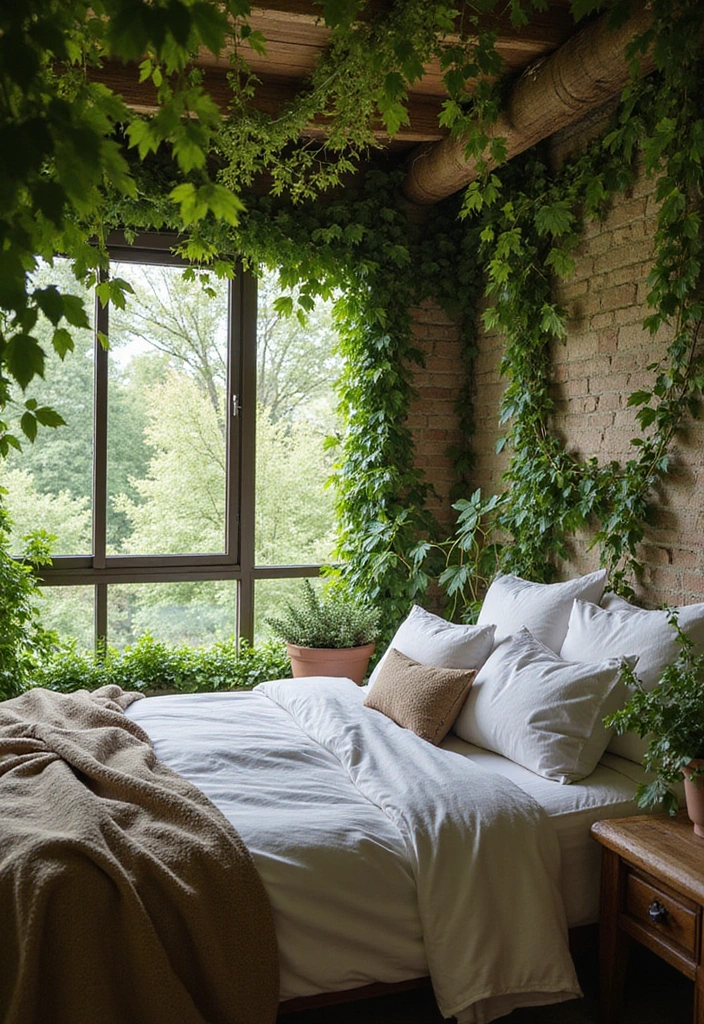
Incorporating climbing vines into your bedroom not only enhances your decor but also fosters a connection to nature that can improve your overall well-being.
From elegant hanging arrangements to vibrant wall displays, there are countless ways to showcase greenery in your small space.
Take inspiration from these ideas and let your creativity bloom as you create a sanctuary that truly reflects your personality.
Frequently Asked Questions
What Are Some Easy Vines to Incorporate in My Bedroom Decor?
If you’re looking to bring nature indoors with minimal effort, consider plants like trailing pothos or the String of Hearts. Both thrive in indirect light and add a beautiful cascading effect to your decor. They require little care, making them perfect for busy lifestyles.
Additionally, air plants in glass terrariums are a fantastic option since they don’t need soil and are easy to maintain!
How Can I Use Vines to Maximize Space in a Small Bedroom?
Using vines is a brilliant way to maximize space without cluttering your small bedroom. Consider installing a wall trellis for ivy or hanging ferns from the ceiling. These options draw the eye upwards, creating the illusion of a larger space while adding a touch of greenery.
You can also use vertical garden walls to display multiple vines without occupying floor space, giving your room a lush, natural vibe.
Do Vines Help Improve Air Quality in My Bedroom?
Yes! Many indoor vines, such as pothos and philodendron, are known for their air-purifying qualities. They can help filter out toxins and improve indoor air quality, which is particularly beneficial in a bedroom where you spend a lot of time.
Incorporating these plants not only enhances your bedroom decor but also contributes to a healthier living environment!
What Should I Consider When Choosing Vines for My Bedroom?
When selecting vines for your bedroom, consider factors like light levels and care requirements. For instance, if your bedroom has bright but indirect light, vines like Hoya or string of hearts would thrive.
Also, think about the overall aesthetic you want to achieve—whether it’s a bohemian vibe or a more minimalist approach. Choose vines that not only fit your space but also resonate with your personal style!
Can I Combine Vines with Other Bedroom Decor Styles?
Absolutely! Vines are incredibly versatile and can complement various decor styles. For a bohemian bedroom, drape vines along shelves or hang them in macramé plant hangers. For a more modern look, consider using unique wall-mounted pots with trailing vines.
Mixing vines with other plants in a mixed planter can create a dynamic display that adds texture and depth. The key is to balance the greenery with your existing decor to enhance the overall look!
Related Topics
vines in bedroom ideas
indoor climbing vines
nature-inspired decor
small space greenery
bohemian bedroom ideas
easy plant decor
vertical gardening
hanging plants
eco-friendly design
bedroom plant decor
decorating with vines
minimalist bedroom

